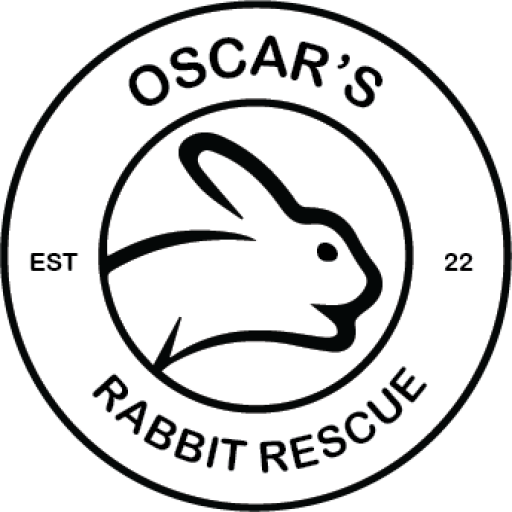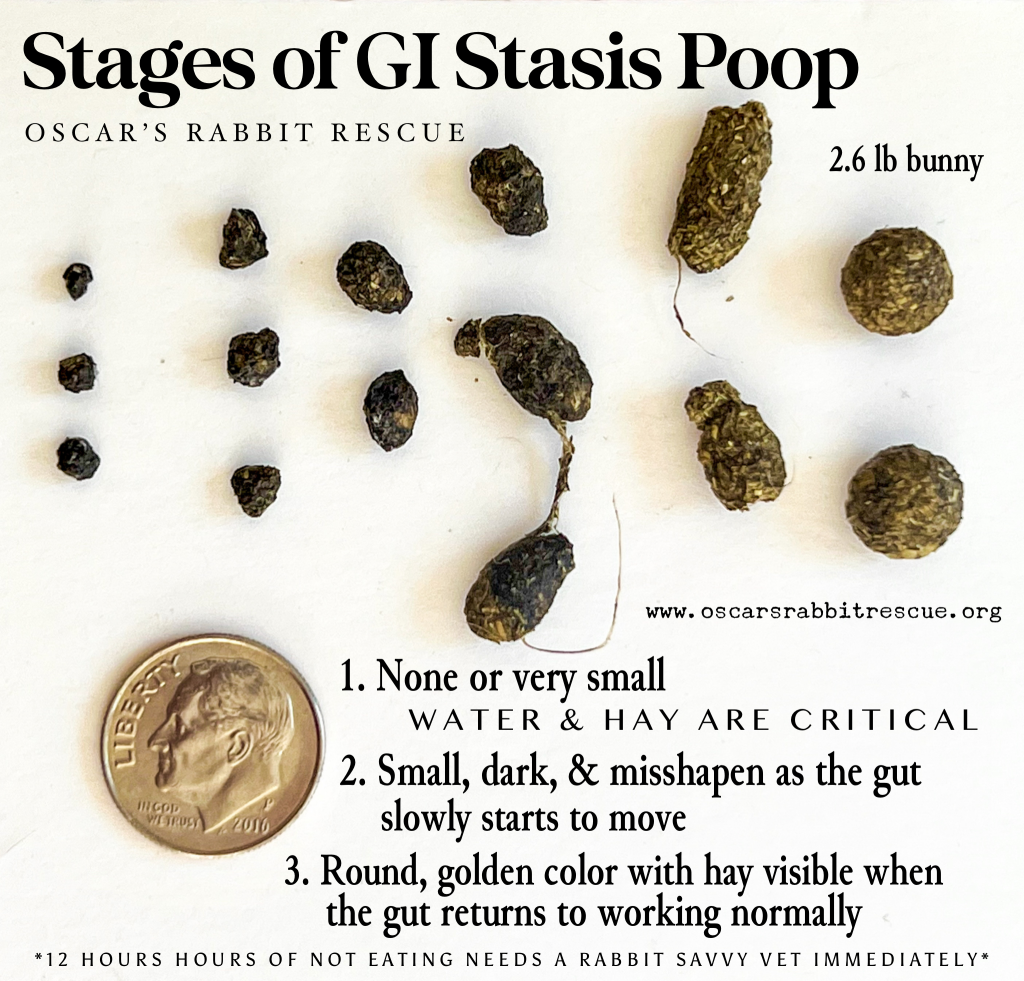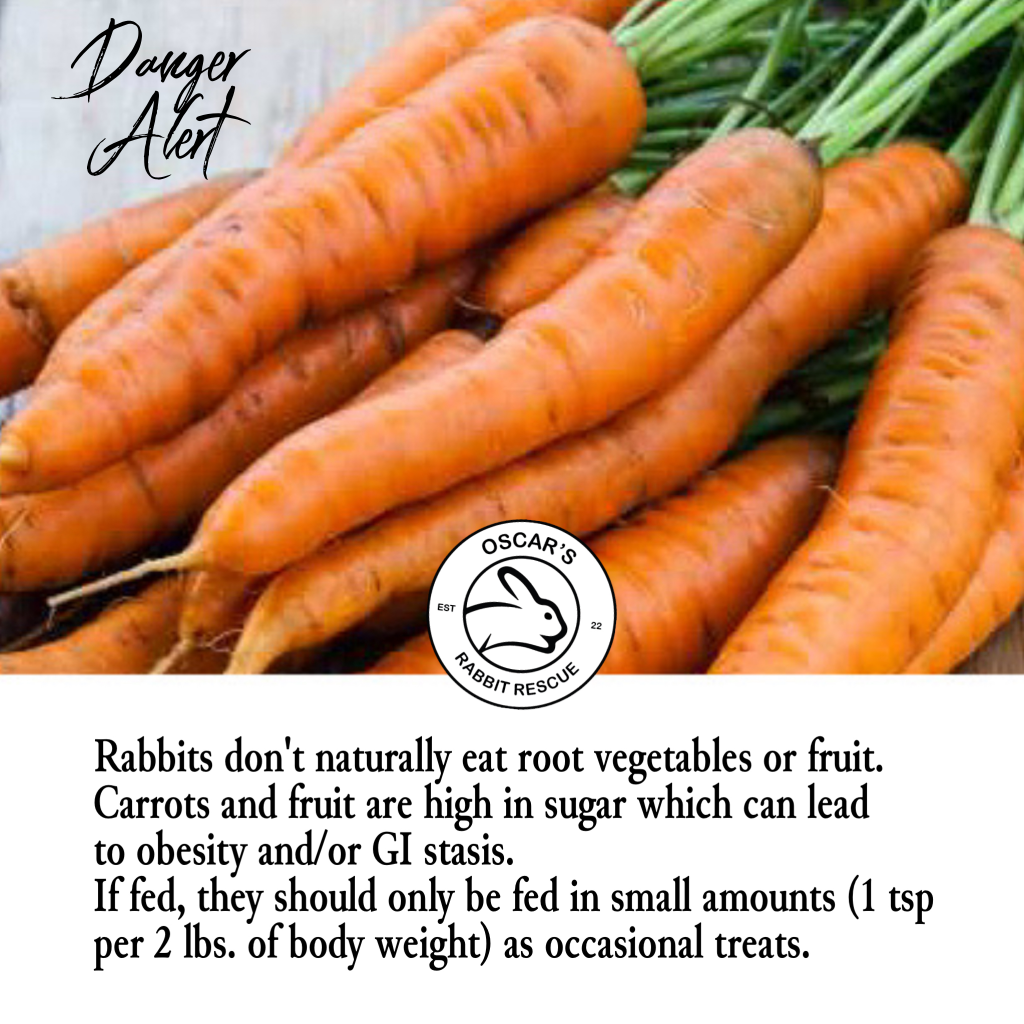
Very important! Many rabbits die regularly due to GI stasis, a quickly fatal condition, frequently caused by improper diets.
Absolutely NO chocolate (poisonous!), corn, seeds, cookies, crackers, breakfast cereals, bread, pasta, yogurt drops, or other “human treats.”
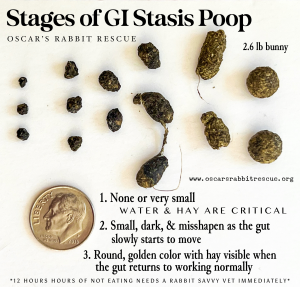
See More about GI Stasis HERE
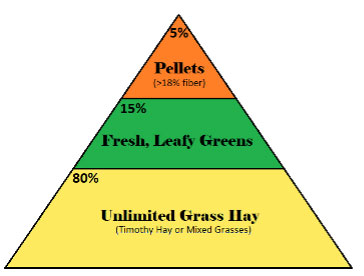 Hay
Hay
Grass hay makes up 80% of a rabbit’s diet and must be available in unlimited quantities at all times. Hay is essential to good health. Hay stimulates the rabbit’s GI tract to work correctly and helps prevent blockages in the GI tract and dental issues by keeping teeth trimmed. Grass hay is rich in Vitamin A and D, calcium, protein, and other nutrients.
IMPORTANT: Before introducing any fresh foods, it is best if your rabbit has been eating grass hay for a minimum of 2 weeks. The grass hay will help to get your rabbit’s GI tract motility and flora in good working order so that he/she will be able to accept new foods more easily.
Provide a variety of fresh, grass hay twice daily as it provides natural foraging to find the best pieces. Your rabbit will dig through the hay to find the best pieces to eat; therefore, never consider what they don’t want to eat “wasted hay.” Varying the type of grass hay or mixing hays is a great idea (e.g., timothy, orchard, oat hay, brome, etc.). Alfalfa is not grass, but rather a legume (in the pea and bean family) and is only safe for rabbits under 6 months of age.
Store hay in dry, temperature-controlled climates out of plastic to prevent mold.
Water
Fresh water must be supplied daily. Please make sure water is always available in a heavy crock/bowl (NO bottles) to encourage drinking. Rabbits need a lot of water every day, and bottles do not allow them to drink as much as they need. Water is necessary to flush excess calcium from the kidneys and bladder, and it is essential for healthy function of the gut and its bacteria.
Pellets
Pellets should be fresh and should be high in fiber (>18%), and low in protein (<14%), calcium (<0.9%) and fat (<2%). Pellets should make up less of a rabbit’s diet as he or she grows older; amounts are based on weight and age (details below). Alfalfa pellets are fine for younger rabbits, but timothy pellets are preferred for older rabbits to prevent kidney stones from too much calcium.
Pellets should NEVER have colored pieces or seeds in them. Always check the ingredients. Many companies sell “adult pellets” that are not timothy based and have poor ingredients in them.
Vegetables
Feed 1 cup of fresh, washed leafy green vegetables for each 2-4 lbs. of body weight. Select at least three types of vegetables daily to offer variety. Fresh vegetables provide nutrients and moisture in the diet, which is good for kidney and bladder function.
IMPORTANT: When introducing new fresh foods to any rabbit’s diet, it is best to go slowly to allow the GI tract and all its important microorganisms time to adjust. Introduce one new food every three days and keep a watch on the stools. Eliminate from the diet if it causes soft stools or diarrhea.
Iceberg lettuce is mostly water and can cause diarrhea; carrots are sugar-rich and may cause intestinal problems in some rabbits. Brassicas (Brussels sprouts, broccoli, cauliflower, cabbage, kohlrabi, mustard greens) may cause gas and soft, smelly poops. Provide them in limited amounts.
Leafy Green Vegetables for Rabbits (75% of fresh portion of your rabbit’s diet)
- Arugula
- Basil (any variety)
- Beet greens (tops)
- Bok choy
- Borage leaves
- Carrot tops
- Chicory
- Celery
- Cilantro
- Clover
- Collard greens
- Cucumber leaves
- Dandelion greens (no pesticides)
- Dill leaves
- Endive
- Escarole
- Fennel (leafy tops & base)
- Green lettuce (not Iceberg)
- *Kale
- Mache
- Mint (any variety)
- Peppermint leaves
- Radicchio
- Raspberry leaves
- Red lettuce
- Romaine lettuce
- Spring greens
- Turnip greens
- Watercress
- Wheatgrass
- Yu Choy
*There is current dispute in the scientific community regarding the levels of oxalates and goitrogens in kale. Some feed it daily without issues while others have found that kale fed in large amounts on a daily basis may contribute to bladder sludge and other health issues.
Rotate Weekly Due to Higher Oxalic Acid Content (1 out of 3 varieties of greens a day)
- Beet greens
- Mustard greens
- Parsley
- Radish tops
- Spinach
- Swiss chard
Sprouts (from 1 to 6 days after sprouting, sprouts have higher levels of alkaloids)
Safe in Moderation (About 1 tablespoon per 2 lbs of body weight a few times per week, not daily)
- Bell peppers
- Broccoli (leaves & stems)
- Carrots (high in sugar)
- Cabbage (any type)
- Celery (cut into small pieces)
- Cucumber
- Pea pods (the flat edible kind)
- Summer squash
- Zucchini
- Edible flowers (chamomile, dandelion, hibiscus, nasturtiums, pansies, rosehips, violets without seeds)
***Grown without chemical sprays/pesticides or bought dried from a reliable vendor***
Fruit
Limit fruits to 1 teaspoon per 2 lbs. of body weight a few times a week, not daily (or 1-2 tablespoons per 5 lbs. of body weight a few times a week) from the list below of high fiber fruits. Cut out fruit if dieting.
Sugary fruits such as bananas and grapes should be used only sparingly, as occasional treats. Bunnies love sweets and will devour them, so be careful. Too much sugar slows the GI tract and leads to GI stasis.
*Remove pits and seeds*
- Apple (without stem & seeds)
- Apricot
- Banana
- (remove peel; no more than about 2 1/8 inch slices a day for a 5 lb rabbit…they LOVE this!)
- Berries (any type)
- Cherries (without pits)
- Kiwi
- Mango
- Melons
- Orange (including peel)
- Papaya
- Peach/Nectarine
- Pear
- Pineapple (remove skin)
- Plum (without pit)
- Star Fruit
Treats (Optional)
Many pet stores sell treats disguised as “healthy” choices; most of these are fat- and sugar-rich and are not healthy at all. Any treat that lists flour or sugar as a main ingredient or corn in it is a NO. The best treats are inexpensive, unprocessed ones: A small apple slice, a slice of banana, 2-3 raisins, a dried and unsweetened cherry or strawberry, a pinch of whole oats, a dish of cooled herbal tea, a small piece of carrot, or spoonful of fresh apple cider. Treats are a fun way to bond with your rabbit, a good way to monitor appetite, and serve as a nice reward when medicine has to be given.
!!! Dangerous / Toxic !!!
- Avocado
- Bread
- Corn
- Dairy Products
- Eggplant
- Flour
- Fruit pits & some seeds
- Garlic
- Iceberg lettuce
- Meat
- Mushrooms
- Nuts
- Onions
- Pasta
- Rhubarb
- Potatoes
- Processed foods (e.g., chips, cookies)
- Seeds
- Sugar (other than small amounts in the safe, moderation list above)
Other: Many plants and flowers. Some are safe, but not all.
Vitamins, Salt or Mineral Block, Rabbit Supplements and “Enhancers”
These are unnecessary if the rabbit is receiving a balanced diet of hay, green-leafy vegetables, and a good quality pellet food fed in limited amounts.
Diet Broken Down By Age:
Alfalfa based pellets we love by Oxbow: Young Rabbit Food
WHAT QUANTITIES OF FOOD SHOULD I FEED BABIES AND “TEENAGERS”?
- 3 to 4 weeks–mother’s milk, nibbles of alfalfa and pellets
- 4 to 7 weeks–mother’s milk, access to alfalfa and pellets
- 7 weeks to 6 months–unlimited alfalfa based pellets, unlimited hay
- 12 weeks–introduce vegetables (one at a time, quantities under 1/2 oz.)
WHAT QUANTITIES OF FOOD SHOULD I FEED YOUNG ADULTS? (6 MONTHS TO 1 YEAR)
- Introduce timothy hay, grass hay, oat hay, and other hays; decrease alfalfa
- Switch to timothy based pellets and decrease pellets to 1/2 cup per 6 lbs. body weight
- increase daily vegetables gradually; make sure your rabbit can tolerate
- fruit daily ration no more than 1 oz. to 2 oz. per 6 lbs. body weight (because of calories)
WHAT QUANTITIES OF FOOD SHOULD I FEED MATURE ADULTS? (1 TO 5 YEARS)
- Unlimited timothy, grass hay, oat hay
- 1/4 to 1/2 cup timothy based pellets per 6 lbs. body weight (depending on metabolism and/or proportionate to veggies)
- Minimum 2 cups chopped vegetables per 6 lbs. body weight; always introduce vegetables and greens slowly to make sure your rabbit can tolerate
- fruit daily ration no more than 2 oz. (2 Tbs) per 6 lbs. body weight.
WHAT QUANTITIES OF FOOD SHOULD I FEED SENIOR RABBITS? (OVER 6 YEARS)
- If sufficient weight is maintained, continue adult diet
- Frail, older rabbits may need unrestricted pellets to keep weight up. Alfalfa can be given to underweight rabbits, only if calcium levels are normal. Annual blood workups are highly recommended for geriatric rabbits.
PREVENTION IS THE MOST IMPORTANT
See More about GI Stasis HERE.
Education/Resources:
- ~Bringing Home a Pet Rabbit~
- ***Diet for a Domestic Rabbit
- Activities
- Ages & Stages of Life
- Baby Bunnies
- Bonding Rabbits
- Emergency Preparedness
- Ear Cleaning
- Enrichment Activities
- GI Stasis in Rabbits
- Grooming & Nail Trimming
- Household Hazards
- Litter & Litter Boxes
- RHDV-2
- Spay & Neuter
- Supplies
- Vets for Your Rabbit
- Wild Bunnies
- Bearded Dragons
- Guinea Pig Guide
- Blog
